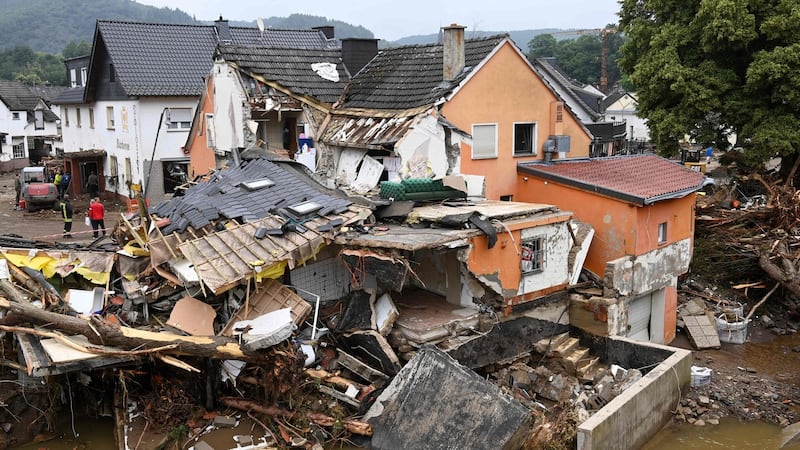Rescue workers continued to search flood-ravaged parts of Germany and Belgium for survivors on Saturday after burst rivers and flash floods this week collapsed houses and claimed at least 170 lives.
"We mourn with those that have lost friends, acquaintances, family members," German president Frank-Walter Steinmeier said during a visit to Erftstadt in the state of North Rhine-Westphalia, where the disaster killed at least 43 people. "Their fate is ripping our hearts apart."
Some 143 people have died in the flooding in western Germany, the country’s worst natural disaster in more than half a century. That included about 90 in the Ahrweiler district south of Cologne, according to police. Hundreds of people are still missing.
About 700 residents were evacuated late on Friday after a dam broke in the town of Wassenberg near Cologne, authorities said.
“Water levels have been stabilising since last night – one can say the situation is stable,” Wassenberg mayor Marcel Maurer said. “It’s too early to give the all-clear but we are cautiously optimistic.”
Dam at risk
The Steinbachtal dam in western Germany, however, remained at risk of breaching, authorities said, after some 4,500 people were evacuated from homes downstream.
Mr Steinmeier called the flooding a tragedy and said it would take weeks before the full damage, expected to require several billions of euro in reconstruction funds, could be assessed.
Armin Laschet, state premier of North Rhine-Westphalia and the ruling CDU party’s candidate in September’s general election, said he would speak to finance minister Olaf Scholz in the coming days about financial support.
In Belgium, the death toll rose to 24, according to the national crisis centre, which is co-ordinating the rescue effort.
“Unfortunately, we have to assume that this figure will continue to rise in the coming hours and days,” the centre said in a statement. About 20 people are still missing.
Over the past several days the floods, which have mostly hit the German states of Rhineland Palatinate and North Rhine-Westphalia and eastern Belgium, have cut off entire communities from power and communications.
RWE, Germany’s largest power producer, said on Saturday its opencast mine in Inden and the Weisweiler coal-fired power plant were massively affected, adding that the plant was running at lower capacity after the situation stabilised.
The utility expects damages to be in the mid double-digit million euro range.
Drinking water affected
In the southern Belgian provinces of Luxembourg and Namur, authorities rushed to supply drinking water to households without a clean supply.
Water levels slowly fell in the worst hit parts of Belgium, though the crisis centre said the situation could worsen in the afternoon along the Demer river closer to Brussels, with about 10 houses under threat of destruction.

Belgian rail network operator Infrabel published plans of repairs to lines, some of which would be back in service only at the very end of August.
Prime minister Alexander De Croo and European Commission President Ursula von der Leyen visited some of the worst affected areas of the country on Saturday afternoon.
Emergency services in the Netherlands also remained on high alert as overflowing rivers threatened towns and villages throughout the southern province of Limburg.
Tens of thousands of residents in the region have been evacuated in the past two days, while soldiers, fire brigades and volunteers worked frantically throughout Friday night to enforce dykes and prevent flooding.
The Dutch have so far escaped disaster on the scale of its neighbours, and as of Saturday morning no casualties had been reported.
Scientists have long said that climate change will lead to heavier downpours. But determining its role in these relentless downpours will take at least several weeks to research, scientists said on Friday.
Many areas are still without electricity and telephone service which, combined with multiple counting in some cases, appears to have accounted for large numbers of missing people that authorities gave immediately after the floods hit on Wednesday and Thursday.
About 700 people were evacuated from part of the German town of Wassenberg, on the Dutch border, after the breach of a dyke on the Rur river.
Train lines and roads remained blocked in many areas of eastern Belgium. The national railway service said traffic would start returning to normal on Monday.
Shore up dykes
Southern parts of the Netherlands have also been hit by heavy flooding, and volunteers worked through the night to shore up dykes and protect roads.
Thousands of residents of the southern towns of Bunde, Voulwames, Brommelen and Geulle were allowed to return home on Saturday morning after being evacuated on Thursday and Friday.
Caretaker prime minister Mark Rutte, who visited the region on Friday, said the region faced “three disasters”.
“First, there was corona, now these floods, and soon people will have to work on clean-up and recovery,” he said.
“It is disaster after disaster after disaster. But we will not abandon Limburg,” the southern province hit by the floods.
His government has declared the flooding a state of emergency, opening up national funds for those affected.
In Switzerland, heavy rain caused several rivers and lakes to burst their banks, with authorities in the city of Lucerne closing several pedestrian bridges over the Reuss river. – Reuters/PA













